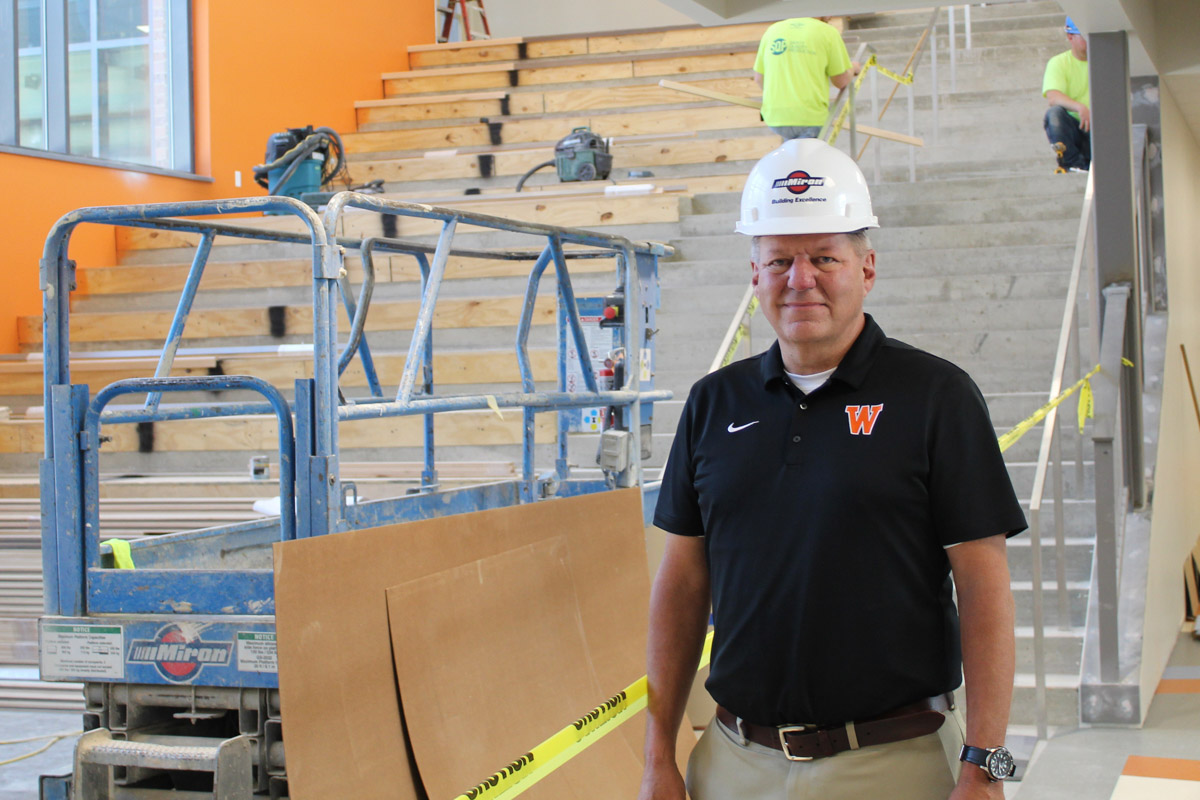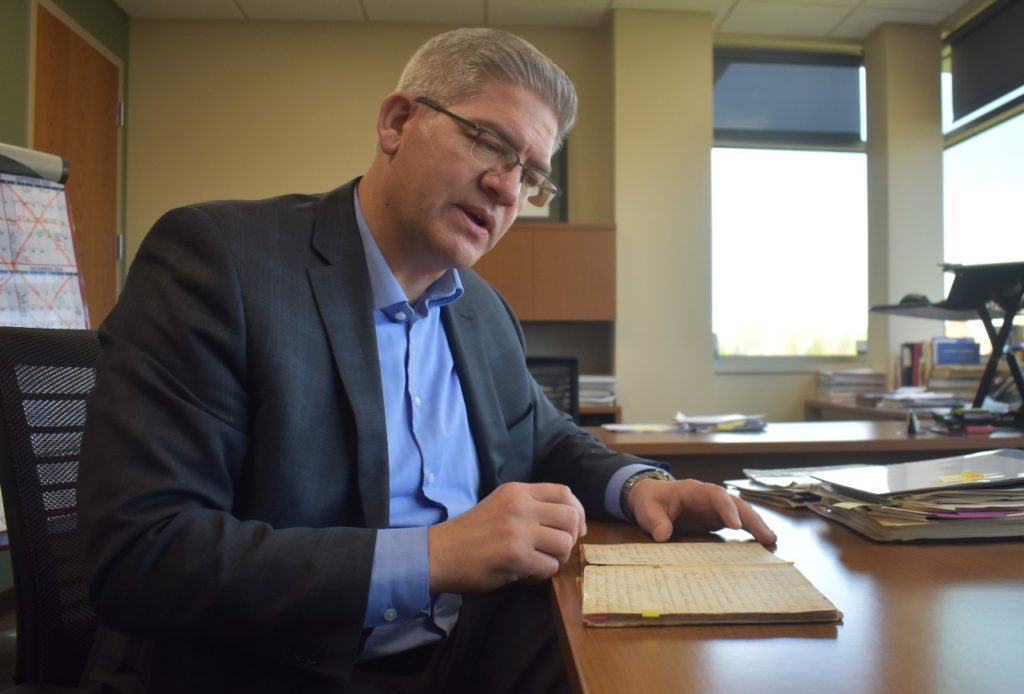

The results of the referendum that would bring $1 billion over 30 years to the Racine Unified School District — and allow the district to revamp buildings dating back to the Civil War — came down to just five votes.
On April 7, 2020, voters approved the referendum by this impossibly thin margin. Little more than two weeks later, observers gathered in Festival Hall and held their collective breath as they watched the recount of 33,315 ballots.
Racine Unified School Board president Brian O’Connell said it felt like watching the final seconds of a championship. After six rounds of ballot-counting, the results were final: The referendum had passed.
It was a hard-fought campaign for the referendum, O’Connell recalled, one that met staunch opposition from HOT (Honest, Open and Transparent) Government, the same group that would later challenge the five-vote victory, appealing all the way to the state Supreme Court.
School officials are awaiting a final verdict from the high court before they break ground on the full slate of projects the referendum money would fund.
Despite its hefty $1 billion price tag, the district says the measure is not projected to increase the property tax rate — although any increase in assessed value will raise individual tax bills.
For now, referendum advocates in Racine applaud increased tax dollars that will allow the district to “right-size” by closing under-enrolled schools, refurbishing and expanding others, and adding new technology, including a science, technology, engineering, arts and math school.
O’Connell said there was no other way to raise the money.
“I think that’s why you see so many school districts, big and small, urban and rural, going to referendum,” he said. “If you find a school district that’s been able to raise money without going to referendum, please let me know.”
Referendum questions common
Increasingly, school districts in Wisconsin are forced to ask voters for approval to pay for everything from maintenance of old school buildings and construction of new schools to employee pay.
Since 2016, more than seven out of every 10 of Wisconsin’s 421 school districts have gone to referendum, with two-thirds of those ballot measures passing, said Ari Brown, a researcher with the Wisconsin Policy Forum.
The frequency with which districts in Wisconsin must exceed state-imposed revenue limits shows the nearly 30-year-old state funding formula is failing to keep up with present-day needs, school officials say.
Prior to 1993, local school districts generally had the authority to raise as much as they deemed necessary and have the local taxpayers to cover it, with the state covering a certain percentage, Brown said. But that year, the Wisconsin Legislature imposed revenue limits in response to concerns by lawmakers and members of the public about rapidly rising tax bills to fund schools.
The limits are based on a complicated formula that takes into account the assessed property in the district, the size of enrollment and past revenue, Brown said. State aid can decrease as property values increase or if student enrollment decreases.
Places like Gibraltar in Door County rely more heavily on property taxes to pay for schools, because the district is considered “property rich,” with 83.8 percent of its operating budget in 2020 coming from property taxes. Districts like Beloit rely more on state aid, because property taxes cover a smaller percentage, 2.5% of its operating budget in 2020.
And proposals by former state superintendent and current Democratic Gov. Tony Evers to change the system — and vastly increase state funding to education — have been rebuffed by the GOP-run Legislature.
Money dries up as enrollment drops
Brown said while the per pupil state aid has increased over time, the rate has not kept up with inflation. From the 2009-10 school year to 2018-19, inflation rose 17%, while the state average revenue limit per pupil increased only 6%, he said.
And if a district’s enrollment decreases, the effect on its bottom line can be magnified, said Dale Knapp, director of Forward Analytics, the research arm for the Wisconsin Counties Association.
“The challenges for school districts is they have a lot of what I would call semi-fixed costs, for example, teachers,” he said. “Suppose your average class size is 25, and you’re a medium-sized district, but you lose 50 students in a year. It’s going to be across multiple grades, so you can’t necessarily in that year lay off two teachers because you have 50 fewer students. ….So your costs don’t decline linearly with enrollment.”
Dan Rossmiller, director of government relations for the Wisconsin Association of School Boards, said this dynamic has created funding problems for many districts — one that is difficult to explain to taxpayers who may oppose increasing taxes to pay for schools where enrollments are declining.
“What’s happened since about the early 2000s is that enrollment has been decreasing,” Rossmiller said. “That’s what’s pinching school district budgets. As enrollment goes down, the state-imposed revenue limit reduces the revenue available to the district. The real problem in explaining this to the public is that every district has a unique situation and a unique explanation.”
A Republican bill that would have made enrollment declines less financially damaging failed to pass the Legislature in 2020.
School officials: Update funding system
The Green Bay Area Public School District, the fourth largest district in the state, is no stranger to referendums — going to voters eight times since 1993.
Its most recent pair passed in 2017, which included $68.25 million for a districtwide building and facilities improvement plan and an operational referendum authorizing the district to exceed the revenue cap by $16.5 million per year for 10 years.
“So the revenue cap is what needs to change — pure and simple,” said Pete Ross, the Green Bay district’s chief operations officer. “It has not increased with inflation in any of the years since it’s been put in place.”
Ross said the cap has locked Green Bay into a level of spending that no longer supports the district’s needs. In 2017, Green Bay’s per pupil spending was $9,691 — well below the state average of $10,444, district spokeswoman Lori Blakeslee said.
“In 1993, we were fixed as a low-spending district and could not move out of that fixed spot we were in,” Ross said. “So going into the 1993 school year, if you were a poor district, a low-spending district, you were destined to be that forever.”
Savion Castro, Madison school board vice president, said even high property value districts like Madison do not fare well under the revenue caps because of the significant needs of some of their students. The district passed a pair of referendums in November 2020 totaling $350 million — $317 million for capital projects and $33 million in operating funds that will phase in over four years.
“We have very, very, very high levels of inequity in our school system. West High School has the highest level of income inequality in the whole state,” Castro said. “Big picture, I think we need to come up with a formula that is reflective of the actual needs of students and the changing demographics that we are seeing in our schools.”
But former Republican state Sen. Luther Olsen, who chaired the Senate Education Committee until 2020, said the nearly 30-year-old funding formula has done the job, curbing what lawmakers and many members of the public felt was unfettered spending by school officials.
“What was happening is that schools were writing checks and the state was having to sign its name on the bottom, and when it said it would fund whatever a school spent, there was no concern,” he said.
Proposals for change stall
Olsen and state Rep. Joel Kitchens, R-Sturgeon Bay, served as co-chairs of the bipartisan Blue Ribbon Commission on School Funding. Both are long-time former school board members in northeastern Wisconsin.
In 2019, the commission put forth 20 recommendations for legislative action — including restoring the state’s commitment of two-thirds funding of school costs, adjusting per-pupil funding with inflation, factoring in the needs of low-income pupils and updating revenue limit formulas. (A complete list of recommendations can be found at tinyurl.com/blueribbonrecs)
The Legislature has taken no action on those proposals, but, said Kitchens, “I would hope that we would still have a chance to get those done this time or in the future.”
Another former school board member, state Rep. Kristina Shelton, D-Green Bay, said Wisconsin needs a school funding formula that is “transparent, equitable and sustainable.”
“Unfortunately,” she said, “what we found is our formula is none of those things, and it is harming Wisconsin kids, families and teachers.”
District relies on history of public support
Howard-Suamico Superintendent Damian LaCroix keeps a powerful reminder of the past, which he hopes is a sign of the future of public education. Nestled on his office bookshelves are the original minutes from a community meeting held in the Town of Pittsfield on Nov. 15, 1856.
“The only thing on the agenda was this group recognizing the need if the community was going to prosper and thrive, they needed to invest in their schools,” LaCroix said.

On that day, those 17 community members agreed on a $200 tax to build a new school house and a $50 tax to pay for a teacher.
Fast forward 165 years, and school finance in 2021 is infinitely more complex — and the needs of students and the community have grown to levels unfathomable in the 1800s.
Because Howard-Suamico was a low-spending district back in 1992, it has held nine referendum questions to boost spending since 2005, seven of which passed.
Most recently, on April 6, district voters approved two referendum questions, including $98 million to renovate learning spaces and operational funding to decrease class sizes, better compensate teachers and maintain facilities.
“Over 160 years ago, leaders in this community recognized education is not an expense, it’s an investment,” LaCroix said. “We have a duty, a moral and ethical obligation, to educate every child and help them maximize their potential.”
Press Times Editor Ben Rodgers and Wisconsin Watch’s Mario Koran and Dee J. Hall contributed to this story. It was produced by the NEW News Lab, a collaboration of newsrooms focusing on issues important to northeastern Wisconsin.



